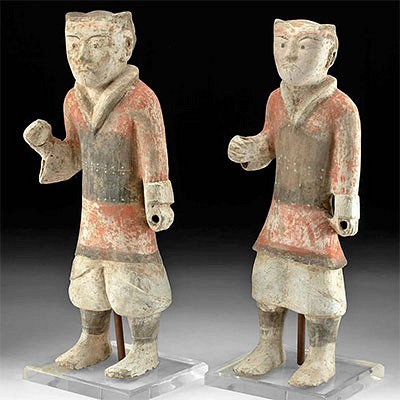Miniature Roman / Holyland Vessels, Pottery & Glass
Lot 9a
About Seller
Artemis Fine Arts
686 S Taylor Ave, Ste 106
Louisville, CO 80027
United States
Selling antiquities, ancient and ethnographic art online since 1993, Artemis Gallery specializes in Classical Antiquities (Egyptian, Greek, Roman, Near Eastern), Asian, Pre-Columbian, African / Tribal / Oceanographic art. Our extensive inventory includes pottery, stone, metal, wood, glass and textil...Read more
Categories
Estimate:
$400 - $600
Absentee vs Live bid
Two ways to bid:
- Leave a max absentee bid and the platform will bid on your behalf up to your maximum bid during the live auction.
- Bid live during the auction and your bids will be submitted real-time to the auctioneer.
Bid Increments
| Price | Bid Increment |
|---|---|
| $0 | $25 |
| $300 | $50 |
| $1,000 | $100 |
| $2,000 | $250 |
| $5,000 | $500 |
| $10,000 | $1,000 |
| $20,000 | $2,500 |
| $50,000 | $5,000 |
| $100,000 | $10,000 |
| $200,000 | $20,000 |
About Auction
By Artemis Fine Arts
May 25, 2023
Set Reminder
2023-05-25 10:00:00
2023-05-25 10:00:00
America/New_York
Bidsquare
Bidsquare : ON-SALE! Antiquities, Pre-Columbian, Ethno, Fine Art
https://www.bidsquare.com/auctions/artemis-gallery/on-sale-antiquities-pre-columbian-ethno-fine-art-12860
ON-SALE Antiquities, Pre-Columbian, Ethno, More! Artemis Fine Arts info@artemisgallery.com
ON-SALE Antiquities, Pre-Columbian, Ethno, More! Artemis Fine Arts info@artemisgallery.com
- Lot Description
Near East, Holy Land, ca. 3rd BCE to 3rd century CE; Roman, Imperial Period, ca. 1st to 3rd century CE. A collection of 3 miniature pottery jars or vases, a Roman glass flask, a mold formed pottery head fragment, and a pottery oil lamp. The head is of a young woman, perhaps a goddess, and the flattened verso suggests she was once an applique or lug on a vessel. Each of the pottery jars have a slender neck and slightly flared spout, and the glass flask is similar in shape and size, is likely these stored sweet and floral oils and perfumes. Size of largest pottery jar: 2" Diameter x 5" H (5.1 cm x 12.7 cm)
Please note these were part of the Leavitt Hunt collection. Hunt (1831 to 1907) was a lawyer, world traveler, and photographer and the first American, if not the first person, to make a photographic record of the Near East and Mediterranean, during his "Grand Tour" from 1851 to 1852, alongside his friend, Nathan Flint Baker (1820-1891). Hunt and Baker captured calotype images of some of the greatest ancient ruins of the Classical World, and these prints are invaluable early artistic photographs as well as historical records of the sites, and several were donated by Hunt's family to the Library of Congress as part of the permanent collection, as well as other institutions. Besides taking photos, artifacts were personally collected by Hunt in the various countries he visited, including these items!
Provenance: ex-Natalie Capron, Vermont, USA, 1972 to 2008, now by her heirs; ex-Maurice Crandall, Vermont, 1941 to 1972; ex-Clyde du Vernet Hunt, Vermont, 1916 to 1941; ex-Katherine Jarvis Hunt, Vermont, 1907 to 1916; ex-Leavitt Hunt, Vermont, collected 1851 to 1852
All items legal to buy/sell under U.S. Statute covering cultural patrimony Code 2600, CHAPTER 14, and are guaranteed to be as described or your money back.
A Certificate of Authenticity will accompany all winning bids.
We ship worldwide and handle all shipping in-house for your convenience.
#174411Chips and abrasions to pottery jars and earthen deposits. Pottery head is a fragment from as larger vessel as shown, with softening to features. Loss to rim of glass vial. Heavy mineral / earthen encrustations on oil lamp.Condition
- Shipping Info
-
All shipping is handled in-house for your convenience. Your invoice from Artemis Gallery will include shipping calculation instructions. If in doubt, please inquire BEFORE bidding for estimated shipping costs for individual items.
-
- Buyer's Premium



 EUR
EUR CAD
CAD AUD
AUD GBP
GBP MXN
MXN HKD
HKD CNY
CNY MYR
MYR SEK
SEK SGD
SGD CHF
CHF THB
THB












